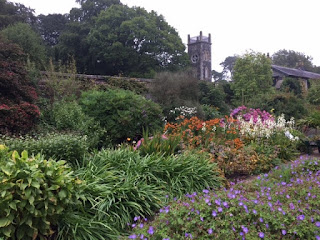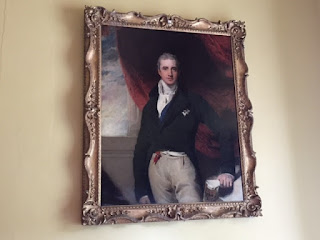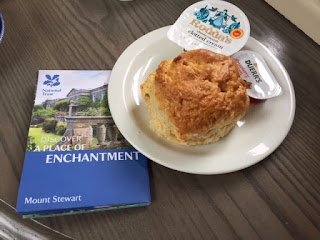Rowallane Garden near Belfast presented me with two very significant challenges:
1. I have a terror of mispronoucing place names - regular viewers will recall my traumas at Trerice last year - and naturally I got Rowallane completely wrong. "I'm off to Roe-a-lane Garden tomorrow!" I trilled to the woman at Castle Ward, who nobly didn't bat an eyelid but said "Oh, it's lovely at Roe-Alan!"
2. It's a garden. Whenever I see a nice garden, I hear Alan Titchmarsh's voice saying "and the gentle willow provides shelter for the charming crocuses that will surely peep through in the Spring" while a trumpet parps away beguilingly in the background, but my trusty inner cynic is always on hard to shout "it took 15 hours of back-breaking work to plant those bulbs". I will not be lulled into a false sense of security that I could be any good at gardening.
Luckily, Rowallane is not one of those extremely neat, structured gardens like Hidcote or Sissinghurst. It does have a nice neat, structured walled garden:
But then the rest of it is more of a rambling estate of trees and shrubs and enclosed areas with boulders and other natural features. I kept expecting to come across a flock of sheep.
There was no guide book so my knowledge is a bit scant:
But onto the scone. Rowallane is the headquarters of the National Trust in Northern Ireland and so I was expecting the scones to be absolutely tip-top.
In fact, it was a very surprising scone. Firstly, it was the cheapest cream tea in NT Scone Blog history - I think it was £2.75. Secondly, the cream was whipped cream and it was available in a big pot by the milk, as was the jam. The scone itself was well-baked but very tasty. I ate the whole thing, which is always a good sign.
Rowallane Garden: 3.5 out of 5
Scone: 4 out of 5
Bargain hunter's score: 5 out of 5
In 2019, I went back to Northern Ireland to complete my rounds. Read more about Carrick-a-Rede, Crom, Castle Coole, Cushendun, Divis and the Black Mountain, White Park Bay, Springhill.
1. I have a terror of mispronoucing place names - regular viewers will recall my traumas at Trerice last year - and naturally I got Rowallane completely wrong. "I'm off to Roe-a-lane Garden tomorrow!" I trilled to the woman at Castle Ward, who nobly didn't bat an eyelid but said "Oh, it's lovely at Roe-Alan!"
2. It's a garden. Whenever I see a nice garden, I hear Alan Titchmarsh's voice saying "and the gentle willow provides shelter for the charming crocuses that will surely peep through in the Spring" while a trumpet parps away beguilingly in the background, but my trusty inner cynic is always on hard to shout "it took 15 hours of back-breaking work to plant those bulbs". I will not be lulled into a false sense of security that I could be any good at gardening.
Luckily, Rowallane is not one of those extremely neat, structured gardens like Hidcote or Sissinghurst. It does have a nice neat, structured walled garden:
But then the rest of it is more of a rambling estate of trees and shrubs and enclosed areas with boulders and other natural features. I kept expecting to come across a flock of sheep.
There was no guide book so my knowledge is a bit scant:
- The garden was created by the Reverend John Moore in the mid 1800s
- His nephew, Hugh Armytage Moore, continued the work
But onto the scone. Rowallane is the headquarters of the National Trust in Northern Ireland and so I was expecting the scones to be absolutely tip-top.
In fact, it was a very surprising scone. Firstly, it was the cheapest cream tea in NT Scone Blog history - I think it was £2.75. Secondly, the cream was whipped cream and it was available in a big pot by the milk, as was the jam. The scone itself was well-baked but very tasty. I ate the whole thing, which is always a good sign.
Rowallane Garden: 3.5 out of 5
Scone: 4 out of 5
Bargain hunter's score: 5 out of 5
In 2019, I went back to Northern Ireland to complete my rounds. Read more about Carrick-a-Rede, Crom, Castle Coole, Cushendun, Divis and the Black Mountain, White Park Bay, Springhill.


















